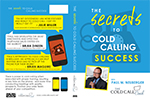Everyone has fears.
But cold calling? C’mon. We’ve covered this ground before. Do your research, be fully prepared … and melt those fears away.
One of the oddest hesitations out there, though, deals with a specific aspect of cold calling: voicemails.
If you’re in sales, you know voicemail well. It’s a tool or a terror, depending on your perspective. The voicemail response rate for cold calls hovers around 1 percent … so it’s probably the latter for most.
Here’s why the callback rate is so bad: Most salespeople stink at leaving voicemails. They talk too long. They try to do too much. They sound like salespeople, without even realizing it.
Which leads to this ludicrous fear about using voicemail: “If the target person hears my name on a message, or my company’s name, they’ll avoid me when I try to call again.”
Fear? Really? No, this falls under “rationalization.”
Or maybe “excuse,” for not knowing how to leave an insightful voicemail, and opting instead to do nothing.
The solution isn’t to quit voicemail. Rather, it’s to quit using crappy tactics.
Look, we all know cold calling isn’t easy. Many sales reps try other means: text campaigns, cold e-mails, Facebook ads and more. None offer the direct targeting, and volume of opportunity, of cold calling.
Success at cold calling requires a plan, and persistence. Even when you reach a live person via cold call, the typical success rate of landing an appointment is barely 7 percent. You don’t have to be average, of course … but it’s your call (pun intended).
Believe it or not, cold calling has actually gotten easier. Why? Because fewer people are trying. It’s too hard. They’ve bought into the “cold calling is dead” myth. Or, they’re just lazy.
The upshot? As fewer cold calls are made, your opportunity to succeed at it grows. People are surprised. Their defenses are down. They’re more willing to engage.
Yes, reaching decisionmakers can still be a challenge. They’re fortified behind a gatekeeper (maybe more than one). This need not be an obstacle. Refer to my last series of articles, which tackled how not to bypass the gatekeeper, but engage them.
Or, maybe the decisionmaker is just rarely at their desk. Important people tend to get stuck in lots of meetings. Sometimes they travel.
So, you can try the tactic of calling at odd hours. Maybe you’ll catch them working very late, or very early. Occasionally this works.
The alternative? Leave a compelling voicemail that piques curiosity, and provides incentive to call back. Yes, it’s possible. The trick is less about what’s said, than what isn’t said.
My next article will examine how to leave this miraculous message. A plan, and practice, can yield amazing results. It’s not rocket science … and, above all, there’s no reason to be scared.



